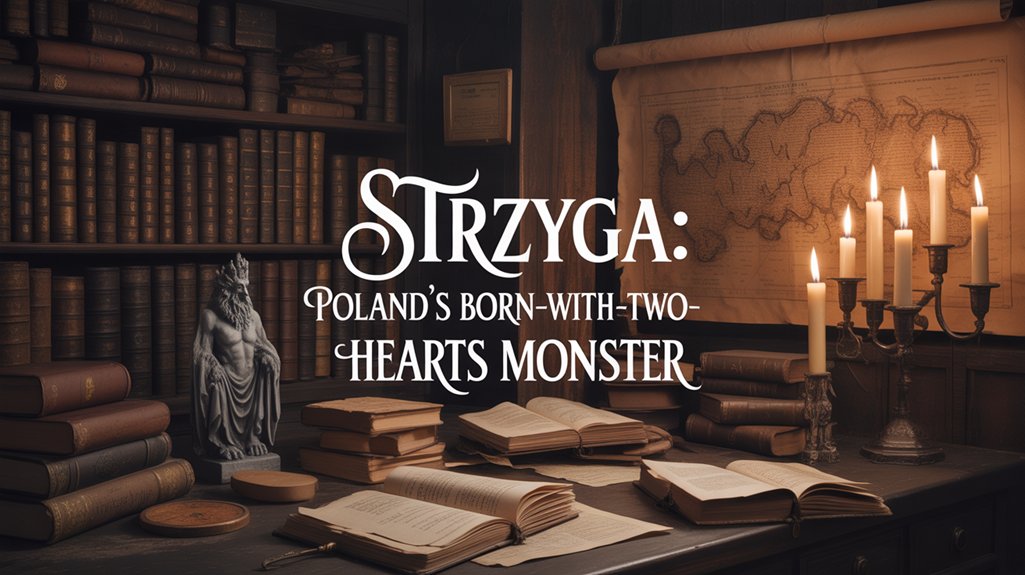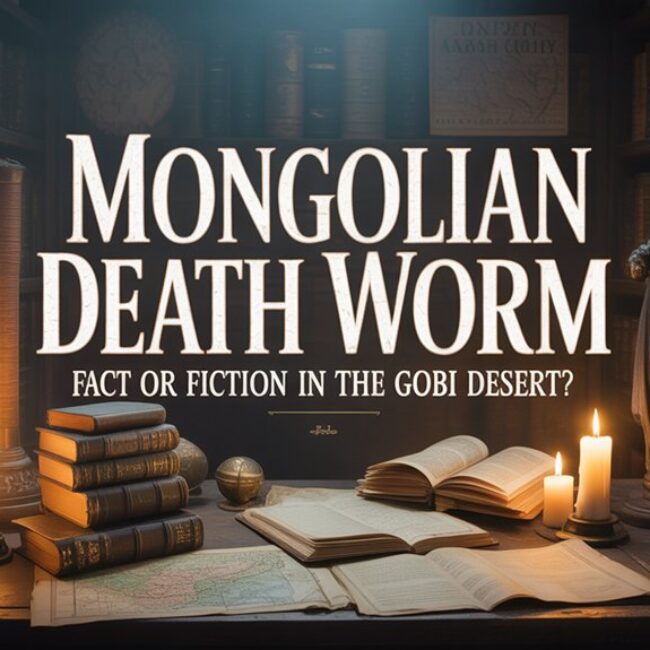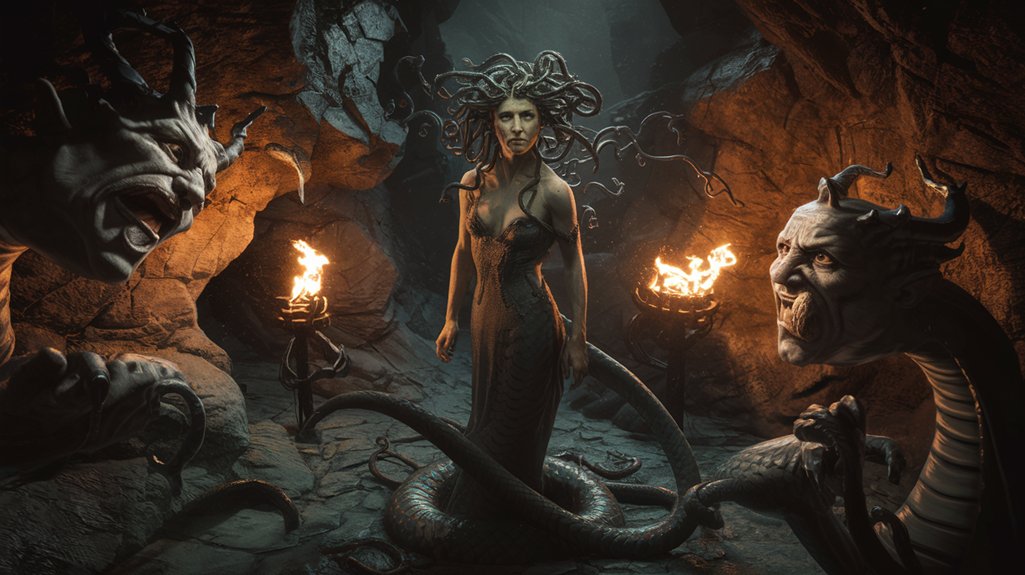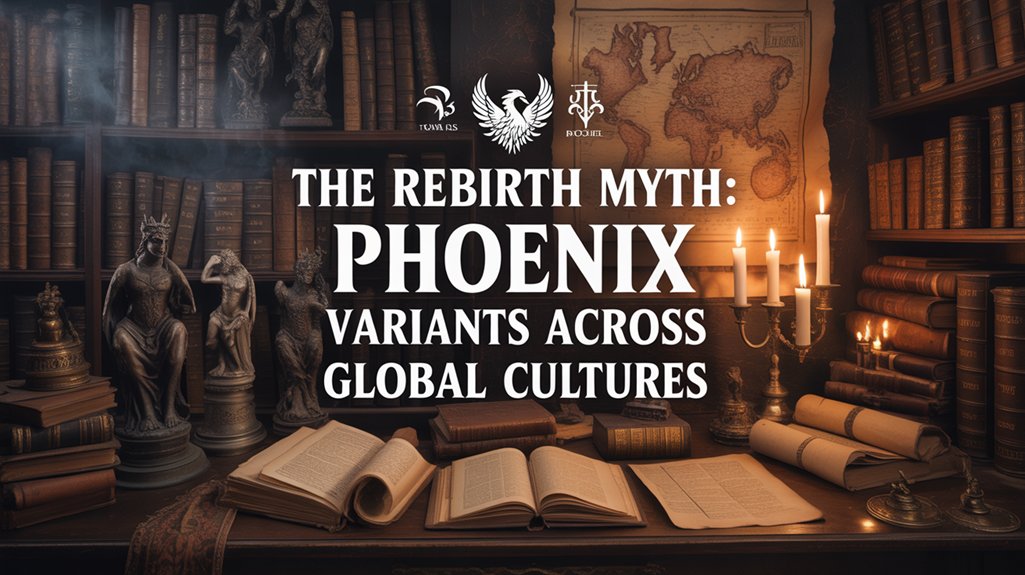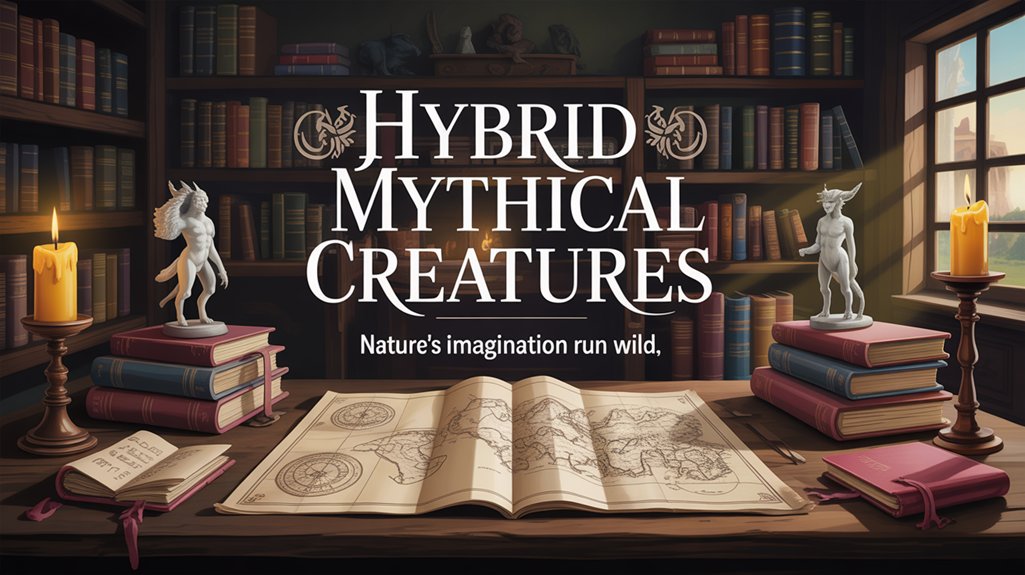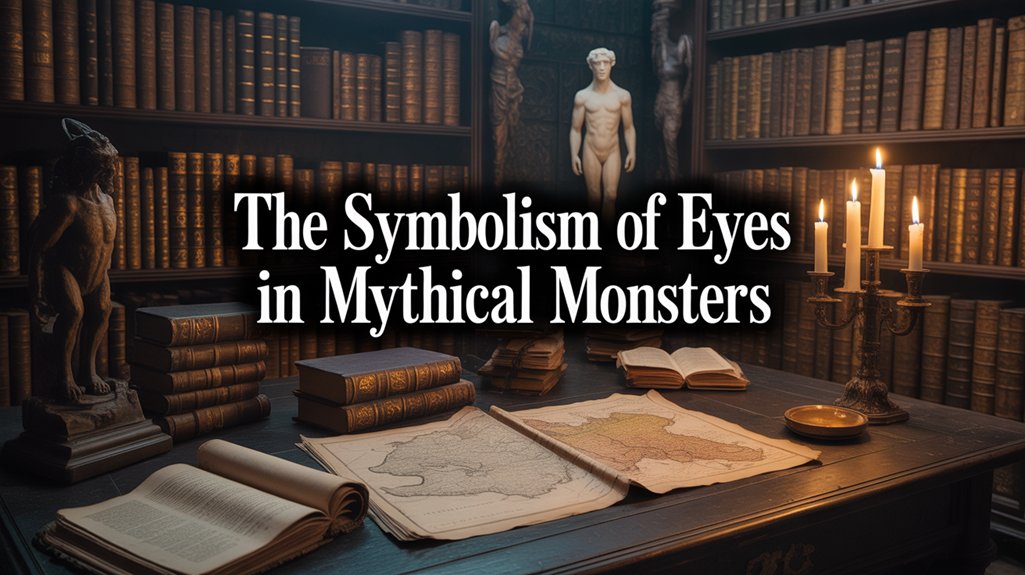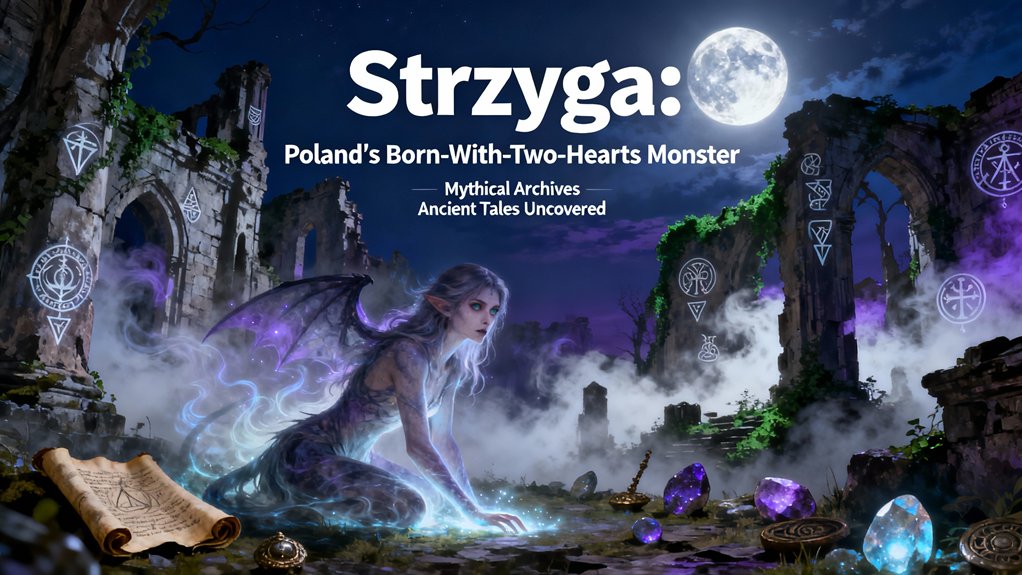
You’ll encounter the strzyga as Poland’s most unsettling folkloric entity—a chimeric being born with two hearts, two souls, and double rows of teeth that mark its cursed existence from birth. This creature straddles mortality and the eldritch domain, its human aspect struggling against insatiable hunger until midnight, when the second soul awakens violently, triggering skeletal restructuring and vampiric bloodlust that targets blood relatives first. The diagnostic markers, alteration mechanics, and regional burial rituals reveal centuries of cultural wisdom preserved against this dual-natured predator.
Table of Contents
Toggle🔮 Enhance Your Practice With These Essentials
Chosen for ritual alignment and energetic correspondence.
🔮 Enhance Your Practice With These Essentials
Chosen for ritual alignment and energetic correspondence.
🎯 Recommended Products
Handpicked items related to this article:
As an Amazon Associate, we earn from qualifying purchases.
🔮 Enhance Your Practice With These Essentials
Chosen for ritual alignment and energetic correspondence.
🔮 Enhance Your Practice With These Essentials
Chosen for ritual alignment and energetic correspondence.
🔮 Enhance Your Practice With These Essentials
Chosen for ritual alignment and energetic correspondence.
Key Takeaways
- Strzyga emerges from birth with two hearts, two souls, and double rows of teeth, marking it as a cursed chimeric being.
- At midnight, the second soul awakens violently, transforming the strzyga into a blood-hungry predator with skeletal restructuring and enhanced senses.
- The creature targets blood relatives first, draining victims nightly through twin puncture marks, causing severe anemia and confusion.
- Communities defend using hawthorn, iron horseshoes, salt pouches, bells, and Catholic blessings at crossroads during dawn and dusk.
- Prevention requires decapitation, face-down burial with limbs bound, poppy seeds scattered, and a sickle placed across the throat.
Born Cursed: The Dual Nature of the Strzyga
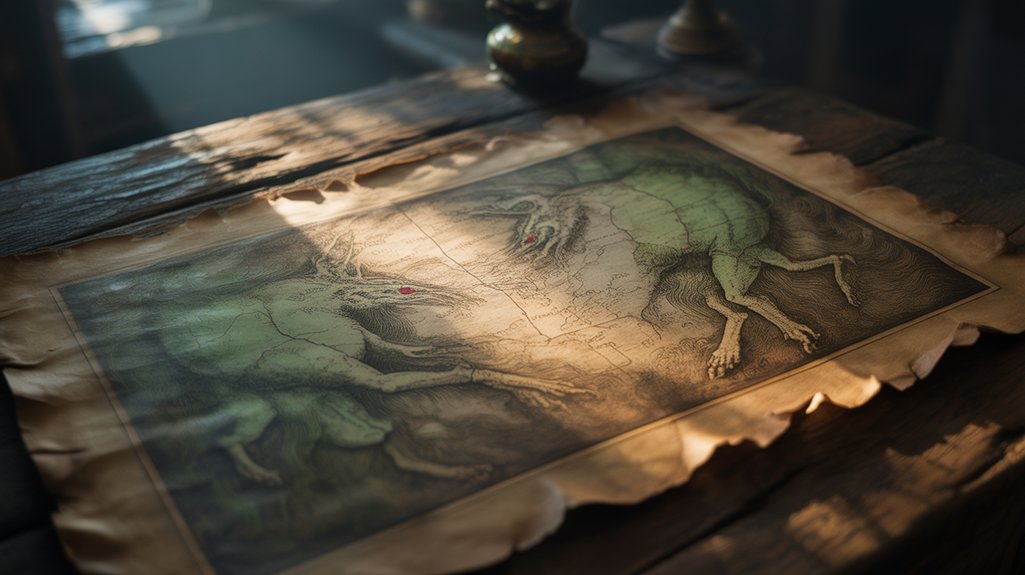
When a child emerged from the womb bearing two hearts, two souls, and two rows of teeth, Polish villages understood that darkness had taken root in human flesh. The strzyga’s cursed origins lay not in demonic possession but in nature’s aberration—a chimeric being straddling mortality and the eldritch domain beyond death’s veil.
This dual existence manifested physically and spiritually. One heart beat with human warmth, the other pulsed with insatiable hunger. One soul craved connection, community, belonging; the other yearned only for blood, for flesh, for the sustenance of the living.
During daylight hours, you’d witness the human aspect—ordinary, perhaps melancholic, struggling against the beast within. But when darkness descended, the second nature awakened.
The alteration wasn’t metaphorical. Witnesses throughout medieval Poland documented the physical metamorphosis: bones cracking, teeth elongating, that second heart thundering louder until human consciousness drowned beneath predatory instinct.
Freedom from this curse? Death alone severed the dual souls’ terrible bond.
Physical Signs That Marked a Strzyga Among the Living
Polish midwives developed an arsenal of diagnostic markers, whispered knowledge passed from generation to generation in birthing chambers where life and monstrosity intersected.
These physical traits carried profound cultural symbolism, marking infants as chimeric aberrations destined for alteration.
You’d recognize a strzyga by these eldritch signs:
- Double rows of teeth – nascent fangs emerging beneath milk teeth, a predatory promise hidden in innocent gums
- Two hearts beating discordantly – palpable through the chest wall, their competing rhythms detectable to experienced hands pressed against infant ribs
- Caul birth with specific markings – membranes bearing crimson patterns resembling crosses or crescents, interpreted as supernatural stigmata
The convergence of multiple markers sealed one’s fate. A single anomaly might warrant vigilance. Three? Irrefutable condemnation.
These physical traits transcended mere superstition—they constituted a diagnostic taxonomy rooted in centuries of observation, fear refined into methodology.
Freedom from such predetermined damnation remained impossible within traditional Polish cosmology.
The Night Transformation: When the Second Soul Awakens

When the sun descends and midnight’s threshold arrives, the strzyga’s dormant second soul—that chimeric essence dwelling within the duplicate heart—violently awakens, triggering a change that Polish folk sources from the 16th century describe as bones shifting beneath skin, teeth elongating into predatory instruments, and eyes reflecting moonlight like those of nocturnal hunters.
You’d witness this alteration as the creature’s human consciousness recedes while an eldritch hunger surfaces, a primal need for blood that supersedes all mortal restraint. The splitting of souls manifests physically: the body convulses, the second heart begins its grotesque pulsing, and what moments before appeared human now becomes something altogether other, suspended between two states of being.
Midnight’s Physical Metamorphosis
As the cathedral bells toll the witching hour, the strzyga’s dormant essence—that primordial second soul coiled within the mortal shell—ruptures through flesh and bone with catastrophic force.
You’ll witness the midnight changes as corporeal reality fractures: vertebrae crack and elongate, incisors pierce swollen gums, eyes alter into reflective amber voids.
This dual existence manifests through three undeniable markers:
- Skeletal restructuring that contorts the spine into predatory curvature
- Dermal pallor draining all warmth into corpse-like translucence
- Sensory amplification expanding perception into eldritch hyperawareness
The alteration completes within moments—a chimeric rebirth wherein humanity surrenders to ravenous appetite.
Dawn alone reverses this metamorphosis, forcing the creature’s return to fragile human guise until darkness summons forth its true nature once more.
Hunger for Blood Awakens
The alteration’s completion triggers an insatiable thirst—not metaphorical longing but physiological necessity—as the awakened second soul demands sustenance that transcends ordinary hunger.
You’re witnessing bloodlust origins rooted in chimeric duality, where Poland’s medieval villages recognized this eldritch craving as proof of cursed existence. The strzyga’s second heart pumps with autonomous rhythm, creating biological imperatives that override human conscience.
Ancient curse interpretations suggest this vampiric appetite stems from the parasitic soul’s incomplete separation from mortal flesh, forever trapped between domains, forever starving. The creature must feed.
Scholars documented how victims displayed dilated pupils, trembling hands, heightened olfactory senses detecting iron-rich blood from remarkable distances. This wasn’t demonic possession—it was metamorphic completion, the alteration’s terrible culmination demanding freedom through consumption.
Signs of Soul Splitting
Before midnight’s toll, witnesses throughout Slavic territories reported observable physiological markers—corporeal warnings that the chimeric alteration had commenced its nocturnal cycle.
You’d recognize the soul fragmentation through these eldritch manifestations, each signaling the dual existence taking hold:
- Eyes shifting from human warmth to predatory luminescence—pupils dilating unnaturally, reflecting moonlight like those of nocturnal hunters prowling forgotten graveyards.
- Skin temperature plummeting precipitously—flesh becoming death-cold despite the strzyga’s accelerating heartbeats, both organs pounding discordantly within a single ribcage.
- Voice deepening into guttural registers—speech patterns fragmenting as the secondary consciousness surfaced, wrestling linguistic control from its daylight counterpart.
These altering signs granted villagers precious minutes.
Escape before complete metamorphosis.
The second soul demanded freedom through violence.
How Strzyga Victims Were Chosen and Attacked

The strzyga’s predatory instincts followed a chimeric logic born from its dual-souled nature, compelling the creature to first drain the lifeblood of its own kin—siblings, parents, children—before expanding its nocturnal hunts to neighbors and village strangers.
You’d recognize the aftermath of such feeding through telltale corporeal signatures: victims exhibited profound anemia, bore twin puncture marks upon neck or chest, and suffered from what Polish folk healers termed “bone-deep exhaustion” that no rest could remedy.
The creature’s hunting patterns aligned with lunar phases, emerging most ravenously during the dark moon when its eldritch second heart demanded sustenance between midnight and the third cockcrow.
Targeting Blood Relatives First
According to Slavic folklore compendiums documented throughout the seventeenth and eighteenth centuries, strzyga demonstrated an unmistakable predilection for consanguineous prey—their own bloodline became their hunting ground.
You’ll find this pattern emerged from the creature’s chimeric nature, that eldritch bond between two hearts creating an inexorable pull toward blood relations. The familial ties that once nurtured now became vectors of doom.
Primary Targeting Hierarchy:
- Immediate household members—parents, siblings, spouses suffered first, drained while they slumbered in false security.
- Extended kinship networks—cousins, aunts, uncles discovered pale and lifeless within fortnight intervals.
- Ancestral village inhabitants—distant relatives sharing bloodline markers fell victim when closer prey diminished.
This preferential predation stemmed from supernatural recognition mechanisms. The strzyga’s dual cardiovascular system detected familiar essence.
Nocturnal Feeding Patterns Explained
While daylight rendered the strzyga dormant within its grave, darkness awakened an insatiable hunger that drove the creature from burial grounds with methodical precision.
You’ll find the strzyga’s nocturnal behavior followed predictable patterns: emergence at midnight, when the veil between worlds thinned to gossamer. Its feeding habits prioritized accessibility over preference—sleeping victims offered no resistance, no witness to eldritch predation.
The creature approached dwellings silently, its chimeric nature allowing supernatural passage through locked doors, sealed windows. You’d never hear its coming. It fed through sustained blood drainage, leaving victims weakened, anemic, confused upon waking.
Multiple visits to the same household proved common, the strzyga returning nightly until detection or death intervened. Dawn compelled its retreat underground, enslaved to circadian tyranny that defined its cursed existence.
Signs of Strzyga Attack
- Blood relatives visiting graves—the creature’s chimeric nature recognized familial essence, drawing it toward genetic connections with eldritch precision.
- Pregnant women and unbaptized infants—liminal souls suspended between states attracted these dual-hearted predators through metaphysical resonance.
- Solitary travelers at dusk—individuals crossing burial grounds during threshold hours became prey, their isolation making them vulnerable to supernatural predation.
You’d recognize an imminent attack through sudden temperature drops, oppressive atmospheric pressure, and the distinctive scent of disturbed earth.
Victims reported paralytic dread before encounters—an ancient, involuntary response to predatory presence that transcended rational understanding.
Village Defense Methods Against the Two-Hearted Monster

When confronted with the eldritch threat of a strzyga prowling their settlements, Polish villagers developed a sophisticated arsenal of protective measures rooted in both pre-Christian animism and later Catholic doctrine.
You’ll find that village rituals formed the primary bulwark against these chimeric predators, with communities gathering at crossroads during liminal hours—dawn and dusk—to perform collective banishments.
Protective charms adorned doorframes and windows: bundles of hawthorn bound with red thread, iron horseshoes positioned points-upward to trap malevolent energies, and pouches containing consecrated salt mixed with graveyard soil.
The apotropaic power of bells resonated through threatened hamlets. Iron fragments. Scattered poppy seeds at thresholds, forcing the strzyga to count each grain until sunrise.
Catholic priests wielded aspergilla loaded with holy water blessed during Candlemas, their incantations merging Latin liturgy with older Slavic invocations.
Communities understood that synchronized defense—spiritual fortification combined with material barriers—offered their only salvation against creatures bearing two beating hearts.
Burial Rituals to Prevent a Strzyga’s Return From the Grave
Once death claimed a suspected strzyga, the community’s true labor commenced—an elaborate mortuary protocol designed to sever the creature’s tether to the corporeal domain. You’d witness burial practices steeped in eldritch necessity, each gesture a binding charm against resurrection.
Death marked not an ending but a threshold—where calculated ritual became the final barricade against resurrection’s dreadful claim.
The villagers employed three principal safeguards:
- Decapitation and corpse manipulation – severing the head, placing it between the legs, ensuring the chimeric entity couldn’t reassemble its dual-hearted form.
- Strategic restraint methods – binding limbs with consecrated rope, positioning face-down internment to disorient any awakening consciousness.
- Protective offerings and barriers – scattering poppy seeds (which the strzyga must count before rising), interring with sickle across throat, layering grave with hawthorn branches.
These weren’t superstitious gestures but calculated defenses, preserved through generations who’d witnessed failed burials.
The protocols varied between regions, yet maintained singular purpose: imprisonment of that which refused natural mortality. Freedom demanded vigilance against those who’d chain communities to cyclical dread.
Regional Variations of the Strzyga Legend Across Poland

Across Poland’s varied topography, the strzyga mythology fractured into distinct regional interpretations, each shaped by local folklore, geographical isolation, and historical trauma. You’ll discover that northern coastal communities feared water-dwelling variants, while southern mountainous regions whispered of chimeric creatures haunting limestone caves. These regional adaptations altered the core legend into something uniquely localized, yet universally terrifying.
| Region | Distinctive Traits | Primary Habitat | Method of Detection | Elimination Ritual |
|---|---|---|---|---|
| Pomerania | Aquatic tendencies, webbed fingers | Coastal cliffs, abandoned fishing villages | Salt circles breaking unexpectedly | Drowning in blessed seawater |
| Małopolska | Twin shadows cast simultaneously | Mountain caverns, ancient burial mounds | Double heartbeat audible at midnight | Stake through both hearts |
| Mazovia | Plague-bearing breath | Forest clearings, crossroads | Animals refusing to cross path | Decapitation, cremation |
| Silesia | Shape-shifting capabilities | Mining tunnels, subterranean spaces | Iron repulsion | Entombment behind iron doors |
| Podlasie | Prophetic utterances before feeding | Marshlands, forgotten shrines | Speaking in reversed Polish | Tongue removal, burial at crossroads |
These folklore variations reveal eldritch truths.
The Strzyga’s Legacy in Modern Polish Culture and Media
Though centuries have passed since villagers last performed protective rituals against the strzyga’s predation, this double-hearted revenant persists within Poland’s contemporary cultural consciousness—transformed from folkloric terror into literary archetype, cinematic antagonist, and symbol of national identity.
From village nightmare to national icon: the strzyga’s evolution mirrors Poland’s own transformation through centuries of cultural memory.
You’ll encounter strzyga symbolism woven throughout modern Polish narratives, where the chimeric creature embodies psychological duality and ancestral trauma.
Contemporary cultural adaptations manifest across multiple media:
- Literature: Andrzej Sapkowski’s fantasy works reimagine the strzyga as intelligent undead, preserving eldritch authenticity while exploring moral ambiguity.
- Gaming: CD Projekt Red’s “The Witcher” franchise presents visceral encounters with these double-souled entities, introducing global audiences to Slavic supernatural heritage.
- Cinema: Polish horror directors resurrect traditional strzyga characteristics—the backwards feet, nocturnal predation—merging folkloric detail with psychological terror.
These adaptations don’t merely entertain; they preserve liminal knowledge, ensuring Poland’s supernatural legacy transcends academic obscurity, remaining essential alive within collective imagination.
Frequently Asked Questions
Can a Strzyga’s Curse Be Broken While the Person Is Still Alive?
You can’t escape this eldritch damnation through conventional means.
Polish folklore offers no redemption for cursed individuals while breath still moves through their chimeric bodies—the dual hearts beat their inexorable rhythm toward inevitable alteration.
Breaking curses of this magnitude requires death itself as catalyst; only post-mortem rituals, including decapitation and positioning the severed head between the legs, sever the strzyga’s otherworldly tether.
The living remain bound, trapped within flesh that harbors monstrous destiny, awaiting their dark transformation.
Were There Documented Cases of Suspected Strzygas in Polish Historical Records?
You’d think medieval Polish clerks would’ve been *excellent* record-keepers about their two-hearted neighbors—yet historical accounts remain frustratingly sparse, scattered through ecclesiastical margins and village testimonies.
Serious folklore analysis reveals fragmented references in 16th-century church documents, burial anomalies noting prone interments, decapitation markings.
These eldritch traces suggest fear’s profound grip on communities confronting chimeric otherness. The strzyga existed in whispered testimony rather than official chronicle—power structures dismissing what peasant wisdom recognized as terrifyingly real.
How Does the Strzyga Legend Compare to Vampire Myths in Neighboring Countries?
You’ll find Strzyga symbolism uniquely emphasizes the dual-hearted anatomy—a chimeric birth defect marking predestined monstrosity—while neighboring Slavic vampires like Russia’s *upyr* or Romania’s *strigoi* typically change through death, curse, or demonic possession.
Regional variations reveal Poland’s Protestant-influenced rationalism: the Strzyga emerges from biological anomaly rather than supernatural contagion.
This corporeal origin distinguishes it from Hungary’s *vámpír* or Serbia’s *vampir*, which demand apotropaic rituals.
Poland demands recognition of nature’s eldritch aberrations themselves.
Did the Catholic Church Have an Official Position on Strzyga Beliefs?
You’ll find Catholic doctrine deliberately obscured strzyga folklore rather than condemning it outright.
The Church absorbed these eldritch beliefs into broader demonic classifications, altering indigenous Slavic monsters into manifestations of Satan’s influence.
Polish clergy neither validated nor entirely dismissed the phenomenon—instead, they reframed dual-hearted creatures as symbols of spiritual corruption requiring exorcism and holy intervention.
This strategic ambiguity preserved ecclesiastical authority while acknowledging the visceral reality your ancestors perceived in darkness.
Are There Any Families in Poland Still Associated With Strzyga Ancestry Today?
You won’t find DNA tests confirming Strzyga ancestry—such eldritch lineages dissolved into Poland’s shadows centuries ago.
Modern-day families guard whispered histories, though few dare claim chimeric bloodlines openly. Rural villages, particularly in southeastern regions near Carpathian foothills, still harbor surnames that locals associate with ancient strzyga legends.
These descendants navigate liminal existence: neither confirming nor denying their heritage. Freedom means choosing silence over revelation, protecting themselves from both skepticism and darker attentions that acknowledgment might summon.
Conclusion
You walk past mirrors, wondering if two reflections might stare back. The strzyga’s dual-souled existence mirrors your own chimeric nature—civilized by day, primal in darkness. Poland’s villages knew this truth: everyone carries contradictions within. When you feel that eldritch pull toward forbidden hungers, remember the strzyga’s curse wasn’t the second heart. It was never choosing which one ruled. Perhaps you’ve already made your choice. Perhaps not.

